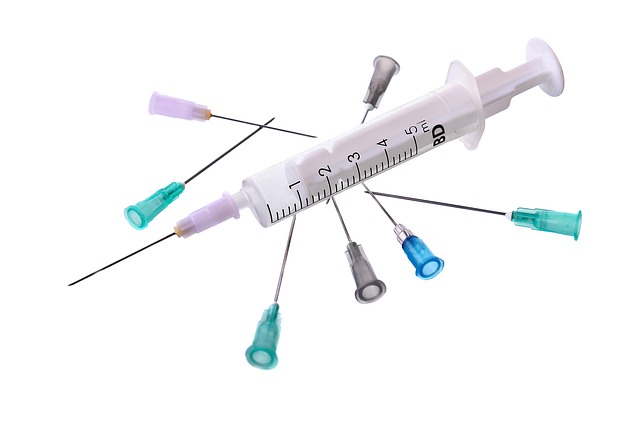Semaglutide, a groundbreaking medication for type 2 diabetes management, mimics natural hormone functions through once-weekly injections, offering consistent glycemic control and proven safety/efficacy. Optimal semaglutide dosing depends on patient factors like health status, weight, age, and concurrent medications, with tailored initial doses starting as low as 0.25 mg. Close healthcare provider monitoring, regular follow-ups, and blood tests are crucial for adjustments based on blood sugar levels, weight changes, and adverse effects to ensure effective, personalized semaglutide dosing.
Discover the power of weekly semaglutide injections in managing diabetes. This comprehensive guide explores semaglutide, its role in diabetes control, and the factors that influence dosing. Learn about the benefits of a weekly injection schedule and what to expect during initial dosage determination. We’ll also cover when and why dosages may need adjustment, plus potential side effects and progress monitoring. Optimise your diabetes management with expert insights on semaglutide dosing.
Understanding Semaglutide and Its Role in Diabetes Management

Semaglutide is a groundbreaking medication that has transformed diabetes management, especially for individuals with type 2 diabetes. It works as an analogue of natural human hormone GLP-1 (glucagon-like peptide-1), which plays a crucial role in regulating blood sugar levels. By mimicking the effects of GLP-1, semaglutide stimulates insulin production and suppresses glucagon secretion, helping to lower blood glucose. This dual action is particularly beneficial for maintaining stable blood sugar control.
The effectiveness of semaglutide lies in its ability to provide significant improvements in glycemic control with once-weekly injections. The dosing regimen allows for a consistent and sustained effect, making it convenient for patients. Semaglutide has been extensively studied, demonstrating its safety and efficacy in various clinical trials. These studies have led to its approval for use in diabetes management, offering a promising alternative to traditional medications.
Factors Influencing Semaglutide Dosing

Several factors play a significant role in determining the appropriate Semaglutide dosing for each individual patient. These include their current health status, weight, age, and other medications they may be taking. For instance, patients with kidney or liver disease might require lower dosages as these conditions can affect the body’s drug metabolism. Similarly, patients with a higher BMI may start on a lower dose to minimize potential side effects.
The goal of Semaglutide therapy is to achieve and maintain blood sugar control while minimising adverse reactions. As such, healthcare providers will closely monitor patients’ responses to dosing adjustments. Regular follow-ups and blood tests are essential to assess the effectiveness of treatment and make any necessary changes to the semaglutide dosage regimen.
Weekly Injection Schedule: What to Expect

The weekly semaglutide injection schedule is a straightforward and convenient approach to managing your medication. Unlike daily injections, this routine offers a more relaxed pace, making it easier to incorporate into your weekly activities. On the designated day, you’ll simply insert the needle and administer the prescribed dose, which typically involves rotating the injection site each week to minimize skin irritation.
You can expect to feel minimal discomfort during the injection process, and many users report that it’s fast and relatively painless. It’s crucial to follow the semaglutide dosing instructions provided by your healthcare professional, as the dosage may vary based on individual health factors. Consistency is key; ensuring you stick to the scheduled days for your injections will help maintain optimal blood sugar control.
Determining Initial Dosage Levels

When introducing weekly semaglutide injections, determining the initial dosage levels is a crucial step in the treatment process. Healthcare providers carefully assess a patient’s medical history, current health status, and specific treatment goals to prescribe an appropriate starting dose. This personalized approach ensures that patients receive the benefits of semaglutide therapy while minimizing potential side effects.
The initial semaglutide dosing typically begins with a low concentration and is gradually adjusted over several weeks. This gradual increase allows the body to adapt to the medication, making it more effective in managing blood sugar levels while reducing the risk of adverse reactions. The dosage journey often starts with a weekly injection of 0.25 mg or 0.5 mg, depending on individual needs, and can be titrated up every week by 0.1 mg increments until the optimal dose is reached.
Adjusting Dosages: When and Why

Adjusting dosages for weekly semaglutide injections is a crucial aspect of treatment, as individual responses to medication can vary greatly. Healthcare providers monitor patients’ progress regularly and make adjustments based on specific needs. This process involves careful consideration of factors like blood sugar levels, weight changes, and any adverse effects experienced by the patient. For instance, if a patient’s blood sugar remains consistently high despite the current dose, a doctor might recommend increasing the semaglutide dosage to enhance insulin sensitivity.
Conversely, if significant weight loss is achieved but at a rate that raises concern, reducing the dose may be advised to prevent potential side effects. The goal is to find the optimal semaglutide dosing regimen for each individual, ensuring better blood sugar control while minimising unwanted outcomes. Regular communication between patients and healthcare teams facilitates these adjustments, leading to more personalised and effective treatment plans.
Potential Side Effects and Monitoring Your Progress

The weekly semaglutide injection is a powerful tool in managing blood sugar levels, but like any medication, it comes with potential side effects. Common issues include gastrointestinal symptoms like nausea, vomiting, or diarrhea, which are often mild and subside over time. Some users may also experience temporary changes in taste perception, decreased appetite, or fatigue. While these effects can be bothersome, they usually resolve as your body adjusts to the semaglutide dosing.
Regular monitoring of your progress is crucial while on this treatment. Your healthcare provider will likely recommend frequent blood tests to check your glucose levels and assess how well the medication is working. They may also ask you to keep a log of your meals, exercise routine, and injection dates to identify patterns and make any necessary adjustments to your semaglutide dosing regimen.
